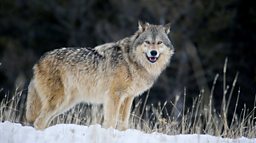Should we be afraid of the wolf?
The wolf has mounted an extraordinary comeback.
Once hunted to extinction across Western Europe, the animal has taken advantage of the collapse of the Iron Curtain and the depopulation of the countryside to spread from east to west, reaching as far as the suburbs of Amsterdam and Brussels. Only Britain, Ireland, Malta, Cyprus and Iceland now lack the top predator that haunts our fairy tales.
For Rare Earth, Tom Heap and Helen Czerski go face to snout with the wolf to find out the secrets of its success. With the help of experts they ask, should we be afraid of the wolf or should we invite it back into Britain?

The wolf was wiped out in Western Europe
“Once upon a time the wolf was the most widespread terrestrial mammal on the planet,” explains writer and wolf aficionado Adam Weymouth. There were 38 subspecies that ranged from the top of the tundra all the way down to the edge of the tropics. “They were this incredibly successful animal, all across the northern hemisphere.”
But then came a human crusade against them. With money came bounties on the wolf’s head. In 812 Charlemagne created a crack force of troops charged with wiping out the wolf in France (although it took them a thousand years). The last definitive date for one in Scotland is 1621.
“Over time we really pushed the wolf right to the edge of extinction,” explains Adam. “By 1965 they’d almost disappeared completely in Europe.”
What is the secret to the wolf's comeback?
Now, the wolf is on the rise. Today’s population is 18 times bigger than it was in 1965 and just in the last ten years it’s nearly doubled.
The fall of the Iron Curtain in 1989 allowed wolves from eastern Europe to start moving west. As the European block came together in 1992 the Habitats Directive was signed, which introduced a lot of protection for species. And fewer people farming has freed up land for the creature.
The roaming nature of wolves has also contributed to them bouncing back. They’re mostly pack animals but when the young are kicked out, they go searching for new territories. “Some of them are hardwired to disperse,” explains Adam. His book, Lone Wolf, tells the story of Slavc, a Slovenian-born wolf who undertook an incredible thousand-mile walk across the Alps. When he arrived in the mountains just north of Verona, he bumped into a female wolf who was on a walkabout of her own. “Somehow, in thousands of miles of space these two wolves – the only two wolves for thousands of miles – found each other,” explains Adam. “Now, in the space of a decade, there are about a hundred wolves back in this area, which are a product of their meeting.”
Wolves are also versatile. There are wolves on the Vancouver islands that swim and catch fish, tiny ones that live in the deserts of Ethiopia, and huge ones that can bring down a moose in the Artic. “They’re incredibly adaptable to their surrounding environment,” states Adam.
Where does our ingrained fear of the wolf come from?
The wolf’s very close relative – the dog – has the moniker of man’s best friend. And yet the wolf is more likely to be seen as a mortal enemy. “Ever since we started keeping sheep the wolf has been the thief and the enemy and the trickster,” says Adam.

A plethora of myths and stories compound this sense of the wolf as a dark threat. Erica Fudge of Strathclyde University studies the history of relationships between animals and people. “There’s a lot of fear running through a lot of stories – whether they’re about actual wolves, werewolves, fantasy wolves,” she states.
Even in Britain – a culture and a society that doesn’t have wolves – we still worry about them. “In Early Modern England, where wolves were not present, this was still a trope that came up again and again,” says Erica. In the 17th century, people saw the wolf as a “demonic threat”; there were legal cases against people accused of transforming into wolves. And our preoccupation with the wolf continues: think Game of Thrones or American Werewolf in London.
The key myth, Erica suggests, is the story of the origin of Rome: Romulus and Remus were abandoned in a forest and suckled by a she-wolf. “At the centre of civil culture is this kind of shadow presence of a wolf,” says the researcher. “The wolf is a kind of marker of the end of civility.”
Wolves are hard to spot, which makes them easy to fear
Despite their ubiquity in much of Europe, wolves are incredibly hard to spot. They have huge territories, and they avoid us, says Adam. In three years of researching his book, the writer got just one brief glimpse of the creature.
ÃÛÑ¿´«Ã½ Central Europe correspondent Nick Thorpe’s book, Walking Europe’s Last Wilderness, is about travelling through the Carpathian heartland. “I didn’t see a single wolf in six years,” he states. “I was much more afraid of dogs.”
Is it their elusiveness that enables us to project our fears on to wolves? A wolf’s howl can travel 10 miles, so they are often heard but not seen. “Being able to hear a wolf rather than see a wolf absolutely is the stuff that we would align with horror films,” says Erica.
Do wolves get a bad rep?
“One of the biggest myths about the wolf is this idea of the alpha, which has actually now been completely discredited,” says Adam. “A wolf pack is not a collection of weak, needy individuals ruled over by a strong man, as certain toxic corners of the internet would have us believe. A wolf pack is essentially a family in various formations.”
They’re incredibly community minded, they’re incredibly faithful, they’re extremely good parentswriter and wolf aficionado Adam Weymouth
Similarly, a “lone wolf” is not a Clint Eastwood archetype; an outsider who favours his own company. “A lone wolf is looking for the same three things that we all are, which is somewhere to live, enough food to eat and a mate.”
There are other characteristics we should focus on, Adam suggests. “They’re incredibly community minded, they’re incredibly faithful, they’re extremely good parents – especially the fathers that will continue to look after both the pups and the mother long after birth.”
Is it time we let wolves loose in Britain?
Nobody in the EU has been killed by a wolf in 40 years, and they take a relatively small number of livestock each year (fewer than one in a thousand across Europe). Should we let them in to the UK?
A paper published in the British Ecological Society journal suggests there might be practical benefits to reintroducing the wolf. Wolves would reduce the number of grazing herbivores, like red deer. This would in turn protect saplings, help trees to grow and sequester carbon.
“I feel there’s in some sense a moral obligation,” says Adam. “We wiped them out and there’s a sense that we would like to have them back.” But wolves undoubtedly pose a threat to farmers that would need managing. “I don’t think it can happen until there is the buy-in of the people who actually live on the land and work with the land.”
For the rest of us, living alongside wolves would mean accepting that nature is more unpredictable than we’ve grown accustomed to. “It’s getting a sense that we are not that top predator,” says Adam (Britain’s largest carnivore is currently the badger) “That’s their symbolism,” says the writer. “They ask us whether we can live alongside the wild again.”
Perhaps our fear of the wolf says more about us than it does about them; we project our own anxieties on to an animal that we can barely even see. Should we try and rewrite the mythology?
“These stories that suggest wolves are not our friends are probably healthy,” concludes Helen. “It’s good for us to have that respect for nature and that bit of fear. But it doesn’t mean we have to kill everything.”
More to discover
-
![]()
Rare Earth
Journalist Tom Heap and physicist Helen Czerski unpack a burning environmental issue each week.
-
![]()
Human Intelligence
Great minds don't think alike. Naomi Alderman examines brilliant brains.
-
![]()
Sliced Bread: Dough
Sam White looks at the business behind profitable, everyday products and considers how they might evolve in the future.
-
![]()
This Natural Life
Martha Kearney takes people to a favourite place to explore their passion for nature.




